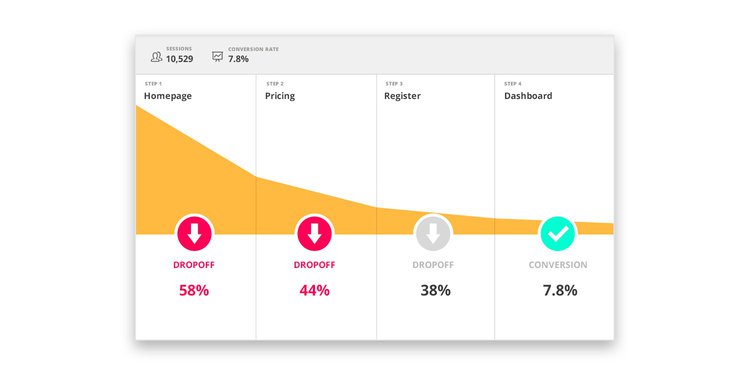
Lots of marketers and business owners use a ‘buyer’s journey’ or ‘sales funnel’ to describe their acquisition process.
But too many focus too much on the beginning of the journey, or the top of the funnel, where leads come in and learn about the offer but don’t convert.
The most effective sales funnel improvements, however, start at the bottom. But before we get into that, let’s clarify what ‘bottom-of-funnel optimization’ even means.
Anatomy of a Sales Funnel
Sales funnels are concepts that businesses use to visualize a customer’s journey from stranger to lead to buyer. As users move closer to a conversion, you can refine your targeting from broad ‘top-of-funnel’ outreach to narrow ‘bottom-of-funnel’ persuasion tactics.
HubSpot, for example, offers a simplified buyer’s journey with just three funnel stages — Awareness, Consideration, and Decision. Depending on your offer and the level of customer education required, your funnel could have more steps, but three is probably the minimum.
If you’re tracking conversion actions as indicators of where buyers are in the funnel, you can see where (and how many) prospects are opting out at each stage:

Once you know how your funnel is performing, you can start running tests and making improvements to reduce the drop-off rate at each level.
Who’s at The Bottom of My Funnel?
Unlike leads who are just learning about your offer or at the comparison shopping stage, bottom-of-funnel prospects know who you are, what you do, and why they need your product or service.
For eCommerce brands, this is a would-be buyer who has already clicked through products on your page. For subscription-based or SaaS companies, this is someone who has downloaded a case study or free trial. Similar client avatars appear in just about every organization’s marketing playbook.
3 Reasons to Start Sales Funnel Optimization at the Bottom
Capturing more of these users can transform your business, via both short-term results and long-term success. But first, let’s look at why starting sales funnel optimization at the bottom is so important.
1. It’s Your Customer Segment Closest to Conversion
Prospects at the bottom of your funnel are typically right on the cusp of taking action. They’ve seen your ads, visited your website, and maybe even put items in a cart.
If you can reduce friction at this stage by proactively answering potential objections, offering social proof, and/or streamlining the conversion process, you’ll capture a larger portion of this segment — and leave less money on the table.
2. Most Impactful Test Results
If you’ve tried to improve sales and marketing campaigns before, you’ve probably analyzed the performance of elements like ads, email campaigns, and landing page headlines. In these cases, success usually comes in the form of better click-through rates, more opened emails, or lower costs per ad click.
None of these metrics are bad per se, and they definitely look good in a report.
But they aren’t quite the same as money in the bank, are they?
In contrast, the results of sales funnel optimization that starts at the bottom are more concrete. You can expect increased sales and subscriptions, less cart abandonment, and a higher return on ad spend (ROAS).
In other words, bottom-of-funnel optimization is the quickest way to bottom-line growth.
3. Compounding Improvements
Another reason for starting with the bottom of your sales funnel, and maybe the most important, is that it sets the stage for improvements everywhere else in your sales process.
In the last section, we mentioned the top- and mid-funnel improvements that come from optimizing your marketing campaigns. Those changes are important, but they’ll be much more successful if you’ve done everything you can to improve the bottom of your funnel so you can maximize user actions at the end of the process.
Where to Start Your Bottom of Funnel Optimization
Even though you’re only working with one section of your funnel, there are still a lot of opportunities to test variants of your process for optimization. Here are a few tactics to try:
Test and refine your checkout process. Lots of users leave a website or platform before converting because of frustrations with checkout. These can include anything from slow page load times to a lack of payment or shipping options to requiring account creation. Tracking data should give you an idea of where drop-offs are happening and where to start making changes.
Urgency. Prospects who are on the fence about converting, especially due to price considerations, might finally pull the trigger if you offer a flash sale or limited-time discount.
Social proof. Showing other buyers’ opinions and experiences with your product helps prospects visualize a positive outcome if they convert. Bottom-of-funnel social proof applications can include:
- Testimonials in a cart abandonment email
- Starred reviews on the cart/checkout page
- User-generated content (UGC) in retargeting ads
Scarcity. Similar to urgency, users who think that a product or service won’t be available soon might overcome remaining objections to make a purchase. (ECommerce brands achieve this effect with a “# in stock” section on a product page.)
Final Thoughts on Sales Funnel Optimization
Once you put the bottom of your sales funnel through the optimization ringer, you should come out on the other side with a more cohesive, useful, and effective conversion process. You’ll also have a foundation for future improvements that will make the rest of your funnel even more successful.
Good luck!
